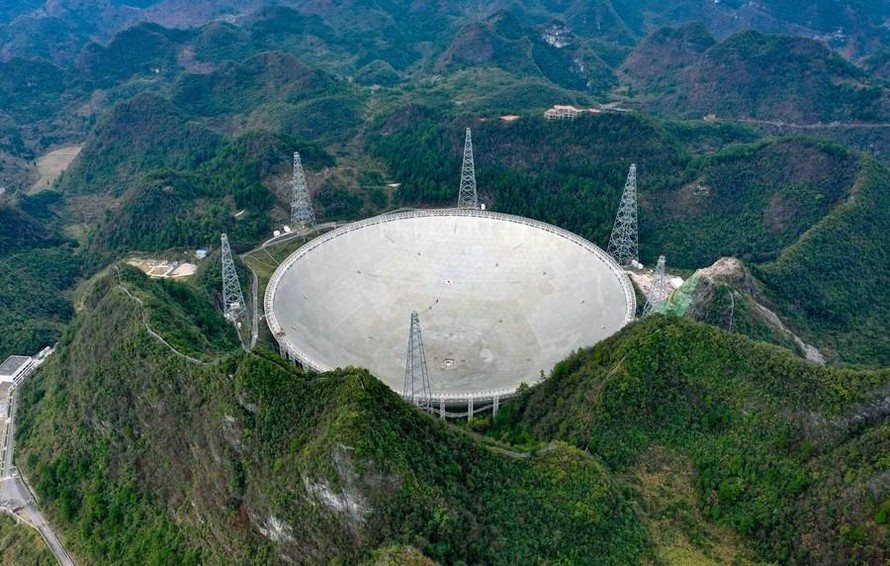China spent nearly 50 million dollars building the largest telescope ever to ‘change the time’ of the whole world
- Tram Ho
According to SCMP, China is about to build the world’s largest radio telescope, with a disc up to 120 meters in diameter. The purpose of this telescope is to provide highly accurate timekeeping, as well as a modern tool for basic research.
The 350 million yuan ($48 million) Jingdong Radio Telescope (JRT) will be located in the mountains of Yunnan province in southern China. The JRT is expected to go into service in 2026 and measure time by tracking radio pulses frequently emitted by pulsars – very fast rotating neutron stars that are considered accurate clocks. most in the universe.
Pulsed stars are very dense neutron stars, which form when massive stars “die” at the end of their lives. According to NASA, a teaspoon of pulsar on Earth would weigh as much as a mountain. As the pulsar rotates, beams of radiation from it sweep across the Earth like a lighthouse. And with their dense properties, they have very stable rotation periods and make them useful tools for scientists.

Together with the “Five-hundred-metre Aperture Spherical Telescope (FAST)”, known as the Tian Eye, in Guizhou province, the telescope in Jingdong will help China develop a time-measuring instrument based on China’s activity. The pulsar is independent and more accurate than the international atomic time service (TAI) used by the whole world, according to Wang Ming, project scientist.
The project will also promote China’s leadership position in the field of radio astronomy and provide pulsar-based navigation and positioning capabilities for Chinese spacecraft in the exploration of radio astronomy, Wang said. future space exploration.
The idea of building a large radio telescope dedicated to studying pulsars was first formed in 2013, the scientist added. After years of research, Wang and his colleagues found found the telescope site in Kinh Dong district. At 2,500 meters above sea level, Kinh Dong’s Mount Ailao nature reserve is virtually noiseless.
Radio telescopes allow astronomers to observe space in a special way. Specifically, the JRT can observe about 3,000 pulsars – hundreds more than similarly sized telescopes, such as the Effelsberg telescope in Germany and the Green Bank telescope in the US.

Celestial Eye Telescope.
The team’s plan, said Wang, is to observe more than 100 pulsars per ms, with the stars rotating hundreds of times per second. The scientists then select the 80 most stable “candidates” to create a grid, and measure and compare the timing of the pulsars.
The purpose of this project is to improve the way time is tracked on Earth. While TAI operates on about 400 high-precision atomic clocks, the system will have a more permanent competitive advantage as neutrons can rotate at an extremely stable rate for decades, even longer.
To date, scientists have used 18 pulsars and five radio telescopes located across Europe to demonstrate that these systems work.
The Chinese system will include three giant telescopes: the JRT, the Qitai radio telescope under construction in Xinjiang, and the Tianyan telescope in Guizhou, Wang said.

Model of Ky Dai telescope.
In addition, the system also helps detect gravitational waves – generated when supermassive den-holes merge in the early universe, creating low-frequency radio wavelengths that distort mid-space- time when they propagate. When such waves pass through the Earth causing the position to change slightly, a series of pulsars can detect that shift if precise enough.
Meanwhile, Wang also said that designers will face a huge structural challenge to build the JRT weighing up to 3,400 tons. Other key technologies used are the design and development of the ultra-wideband, low-noise receiver feed, which the team has been working on since 2020.
The construction of the telescope will strengthen China’s position in large-scale machine design, automatic control, low-temperature electronics and system integration, according to Wang. In addition, he also looks forward to completing the construction soon and sharing the observational data with the scientific community.
Refer to SCMP
Source : Genk
